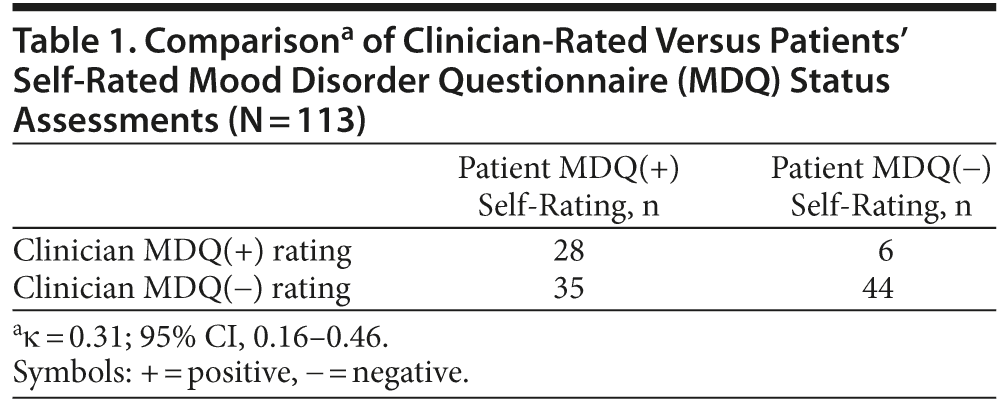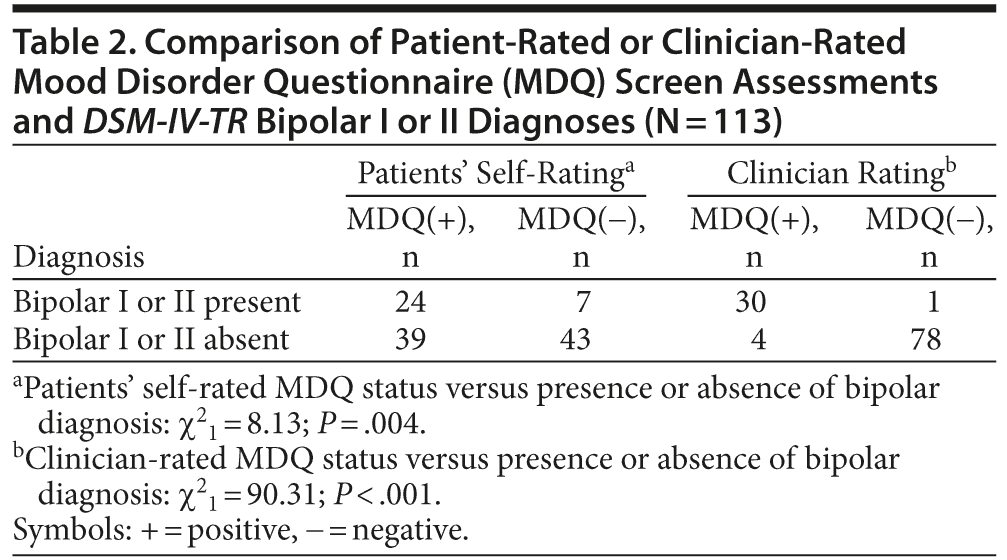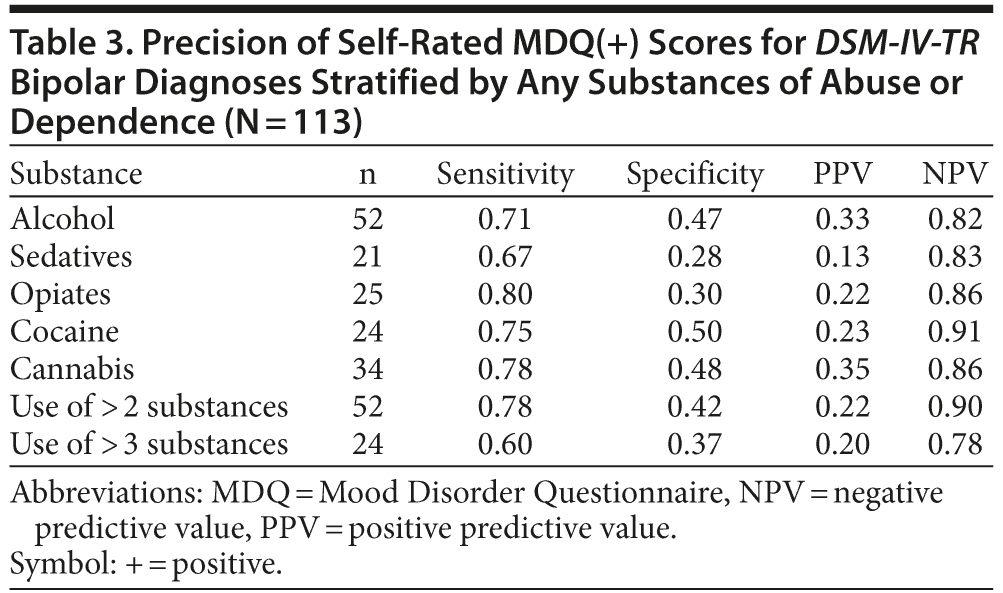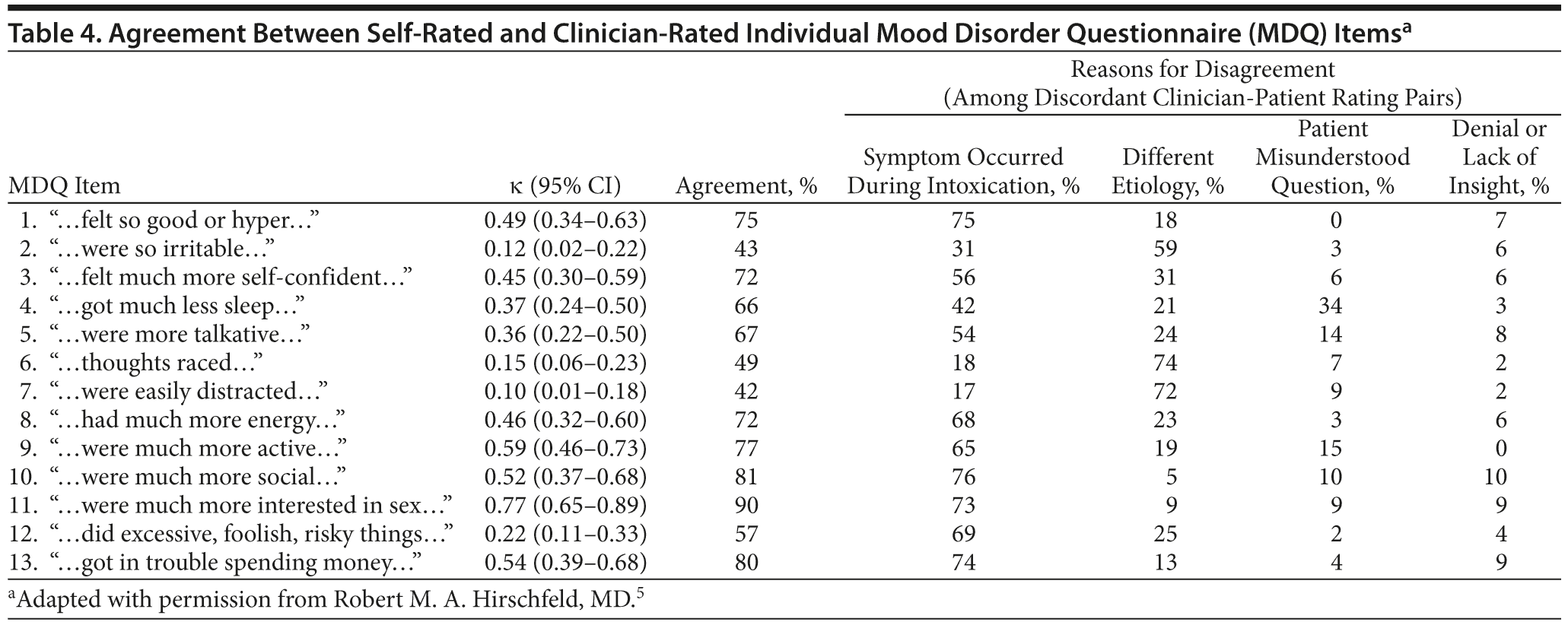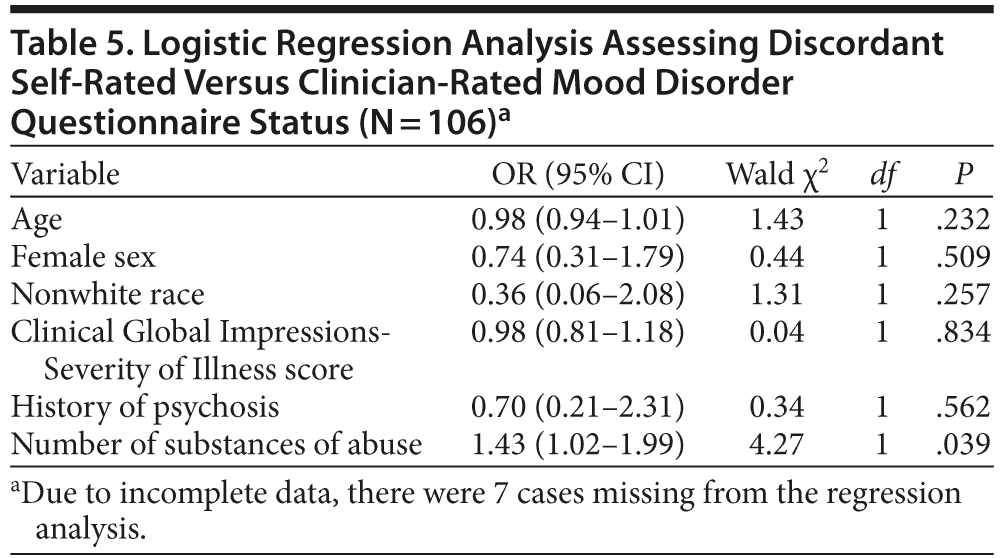Background: Self-rated screening studies suggest higher prevalence rates for bipolar disorder than previously thought, but the validity of self-administered diagnostic tools has not been well established in mood-disordered patients with substance misuse.
Method: We conducted a cross-sectional assessment of 113 English-speaking, nonintoxicated adults aged 18-69 years who were seeking treatment for mood or anxiety symptoms and substance use symptoms. (Subjects with anxiety complaints at initial presentation were included to possibly increase the pool of subjects with mood symptoms upon formal evaluation.) Subjects were consecutively evaluated from January 2010 through May 2011 at the time of voluntary admission to a private, not-for-profit psychiatric hospital. All subjects completed the Mood Disorder Questionnaire (MDQ), followed by a psychiatrist’s review of their responses, using the MDQ as a semistructured interview. MDQ item and total agreements were compared for patient self-report versus clinician interview, alongside analysis of reasons for discordance. DSM-IV-TR criteria were used as the basis for diagnoses of bipolar disorder, other mood disorders, and substance use disorders.
Results: An MDQ positive (+) status was scored more often by subjects through self-report (56%) than by the clinician after review of subjects’ MDQ responses (30%) (P < .001). Patients’ self-rated MDQ(+) status had high sensitivity (0.77), modest specificity (0.52), low positive predictive value (0.38), and high negative predictive value (0.86) for bipolar I or II diagnoses. MDQ item ratings having the lowest patient-clinician concordance were irritability (κ = 0.12), racing thoughts (κ = 0.15), and distractibility (κ = 0.10), while highest concordance was observed for excessive spending (κ = 0.54), increased goal-directed activity (κ = 0.59), and hypersexuality (κ = 0.77). Patient-clinician MDQ item discordance most often resulted from patients’ affirmative mania symptom endorsements during past intoxication states. Logistic regressions indicated that discordant patient-clinician MDQ total scores were significantly associated with the number of lifetime substances of abuse (odds ratio = 1.43; 95% CI, 1.02-1.99) but not with any 1 particular substance.
Conclusions: Past or current substance misuse confounds the reliability of MDQ bipolar self-assessment screening. Clarification of MDQ self-rated responses via interview probing yields a more sensitive and specific indicator of likely bipolar diagnoses.
J Clin Psychiatry 2012;73(12):1525-1530
© Copyright 2012 Physicians Postgraduate Press, Inc.
Submitted: June 3, 2012; accepted August 3, 2012.
Corresponding author: Joseph F. Goldberg, MD, 128 East Ave, Norwalk, CT 06851 ([email protected]).
Find more articles on this and other psychiatry and CNS topics:
The Journal of Clinical Psychiatry
The Primary Care Companion for CNS Disorders
ABSTRACT
Background: Self-rated screening studies suggest higher prevalence rates for bipolar disorder than previously thought, but the validity of self-administered diagnostic tools has not been well established in mood-disordered patients with substance misuse.
Method: We conducted a cross-sectional assessment of 113 English-speaking, nonintoxicated adults aged 18-69 years who were seeking treatment for mood or anxiety symptoms and substance use symptoms. (Subjects with anxiety complaints at initial presentation were included to possibly increase the pool of subjects with mood symptoms upon formal evaluation.) Subjects were consecutively evaluated from January 2010 through May 2011 at the time of voluntary admission to a private, not-for-profit psychiatric hospital. All subjects completed the Mood Disorder Questionnaire (MDQ), followed by a psychiatrist’s review of their responses, using the MDQ as a semistructured interview. MDQ item and total agreements were compared for patient self-report versus clinician interview, alongside analysis of reasons for discordance. DSM-IV-TR criteria were used as the basis for diagnoses of bipolar disorder, other mood disorders, and substance use disorders.
Results: An MDQ positive (+) status was scored more often by subjects through self-report (56%) than by the clinician after review of subjects’ MDQ responses (30%) (P < .001). Patients’ self-rated MDQ(+) status had high sensitivity (0.77), modest specificity (0.52), low positive predictive value (0.38), and high negative predictive value (0.86) for bipolar I or II diagnoses. MDQ item ratings having the lowest patient-clinician concordance were irritability (κ = 0.12), racing thoughts (κ = 0.15), and distractibility (κ = 0.10), while highest concordance was observed for excessive spending (κ = 0.54), increased goal-directed activity (κ = 0.59), and hypersexuality (κ = 0.77). Patient-clinician MDQ item discordance most often resulted from patients’ affirmative mania symptom endorsements during past intoxication states. Logistic regressions indicated that discordant patient-clinician MDQ total scores were significantly associated with the number of lifetime substances of abuse (odds ratio = 1.43; 95% CI, 1.02-1.99) but not with any 1 particular substance.
Conclusions: Past or current substance misuse confounds the reliability of MDQ bipolar self-assessment screening. Clarification of MDQ self-rated responses via interview probing yields a more sensitive and specific indicator of likely bipolar diagnoses.
J Clin Psychiatry 2012;73(12):1525-1530
© Copyright 2012 Physicians Postgraduate Press, Inc.
Submitted: June 3, 2012; accepted August 3, 2012 (doi:10.4088/JCP.12m07926).
Corresponding author: Joseph F. Goldberg, MD, 128 East Ave, Norwalk, CT 06851 ([email protected]).
Recent years have witnessed increasing debate over both the possible underdiagnosis1,2 and possible overdiagnosis3,4 of bipolar disorder. On the basis of concerns that many depressed patients with previously unrecognized manias or hypomanias are misidentified as having unipolar depression,1 public health initiatives have called for routine screening for lifetime manias and hypomanias in patients who present with depression. One effort to facilitate such assessment has been the development of self-report screening instruments for bipolar disorder, such as the Mood Disorder Questionnaire (MDQ).5 While early studies conducted with mood disorder clinic participants5 or community survey respondents6 found high MDQ sensitivity (0.735) and specificity (0.905; 0.976) characteristics for DSM-IV-TR bipolar diagnoses, later reports suggested lower predictive value among diverse psychiatric outpatients (eg, positive predictive value [PPV] = 0.307), particularly in patients with substance use disorders (sensitivity = 0.67, specificity = 0.77),8 bipolar II and bipolar not-otherwise-specified diagnoses (sensitivity = 0.30),9 or trauma histories (sensitivity = 0.62, specificity = 0.69).10 Scores on the MDQ may also be less reliable among patients with specific phobias, posttraumatic stress disorder, eating disorders, impulse-control disorders, and attention-deficit/hyperactivity disorder.11,12 Furthermore, while the MDQ was originally designed as a self-report questionnaire, it remains undemonstrated whether its performance characteristics differ when scores are obtained through patients’ self-administration rather than through interview-based probing, clarification, and contextualization of individual items.
The present study sought to evaluate performance characteristics and reliability of MDQ scores when rated at the time of psychiatric hospitalization by patient self-report versus rating by a psychiatrist evaluator who implemented the MDQ as a semistructured interview to review and clarify self-rated responses. We focused on adults with current mood symptoms and clinically significant alcohol or substance misuse. Prior findings by our group,4 assessing an earlier sample of patients from the same setting, revealed that only one-third of substance-abusing mood-disordered subjects who were diagnosed with bipolar disorder by community practitioners met DSM-IV-TR criteria for bipolar I or II disorder, often because mood symptoms arose solely in the context of intoxication states and active substance misuse or because patients identified too few corroborative signs of mania or hypomania to establish a lifetime manic or hypomanic episode. Yet, because many patients with substance use disorders apparently are suspected of having comorbid bipolar disorder,13 further research is needed to help clarify discrepant perceptions about the constituent elements of mania or hypomania by clinicians (and patients) regarding this population.
The specific aims of the current study were as follows:
- To examine the associations between patient self-rated and clinician/interviewer-rated MDQ scores and to identify reasons for discordance.
- To determine the sensitivity, specificity, PPV, and negative predictive value (NPV) of self-rated versus clinician-rated MDQ scores in patients with DSM-IV-TR diagnoses of bipolar disorder.
- To assess the relationship between clinically significant alcohol or substance misuse and clinician-rated/patient-rated concordance of MDQ scores among inpatients with co-occurring mood symptoms and substance misuse.
METHOD
We conducted a cross-sectional assessment of 113 English-speaking, nonintoxicated adults aged 18-69 years who were seeking treatment for mood or anxiety symptoms and substance use symptoms. Subjects were consecutively evaluated from January 2010 through May 2011 at the time of voluntary admission to Silver Hill Hospital, a private, not-for-profit psychiatric center in New Canaan, Connecticut. After providing written informed consent, subjects rated themselves with the MDQ and were subsequently interviewed by one of the authors (A.G.) to assess lifetime illness features (eg, age at onset of first mood disturbance, lifetime suicide attempts, lifetime psychosis, past hospitalizations and treatments, and family history of affective disorders), to review in detail their MDQ responses and DSM-IV-TR criteria for lifetime manic or hypomanic episodes, and to assess DSM-IV-TR alcohol or substance abuse or dependence. Substance abuse and dependence were collectively identified as misuse for purposes of the current study. We imposed the DSM-IV-TR “E” criterion for bipolar mania—”symptoms . . . are not due to the direct physiological effects of a substance (eg, a drug of abuse . . .)”14(p362)—alongside the “B” criterion for DSM-IV-TR substance-induced mood disorder—”the symptoms . . . developed during, or within a month of, substance intoxication or withdrawal.”14(p409) Clinical ratings also included the Clinical Global Impressions-Severity of Illness (CGI-S) scale15 (rated by the research psychiatrist/interviewer) and the Quick Inventory of Depressive Symptoms-Self Report (QIDS-SR16).16

- Self-reported screening for bipolar disorder using the Mood Disorder Questionnaire (MDQ) may often yield false-positive results in patients with mood symptoms and substance misuse—particularly those with lifetime misuse of multiple substances.
- Adapting the MDQ to an interview format enables clinicians to probe and clarify patients’ affirmative item endorsements, in turn substantially increasing the likelihood for identifying true cases of bipolar disorder.
- In mood-disordered patients with substance misuse, negative self-report MDQ screens suggest the absence of bipolar disorder with relatively high confidence.
The study group included 31 individuals who met DSM-IV-TR criteria for bipolar I (n = 24) or II (n = 7) disorder, while the remainder were identified as having major depressive disorder (n = 26), a mood disorder not otherwise specified (n = 36), a substance-induced mood disorder (n = 16), an anxiety disorder not otherwise specified (n = 3), or a psychotic disorder not otherwise specified (n = 1). Research diagnoses were established by consensus agreement between 2 of the authors (J.F.G. and A.G.) on the basis of review of DSM-IV-TR symptoms assessed in research interviews, through probed MDQ responses, and in chart records, which in nearly all cases included documentation of interviews with at least 1 family member or other collateral informant.
As per established criteria,5,6 MDQ(+) ratings pertained to lifetime symptoms and were defined by patients’ self-rated scores of ≥ 7 on the first 13 items, plus endorsement that the identified problems occurred contemporaneously and caused “moderate” or “severe” functional impairment.
Data were analyzed using SPSS for Windows, version 11.5 (SPSS Inc; Chicago, Illinois). Mean group differences were analyzed by paired t tests, while dichotomous variables were analyzed by the Fisher exact test or the χ2 test. Strengths of associations between variables were examined by Pearson correlation coefficients and by logistic regression analyses with generation of odds ratios (ORs) and accompanying 95% CIs. κ Coefficients were calculated to measure concordance between patients’ self-rated and clinician-rated MDQ status scores, along with sensitivity, specificity, PPV (the ratio of true-positive cases divided by the sum of true-positive and false-positive cases), and NPV (the ratio of true-negative cases divided by the sum of true-negative and false-negative cases). All statistical tests were 2-tailed, with an α level of .05.
The study protocol was approved by the Western Institutional Review Board, Olympia, Washington.
RESULTS
The study group as a whole had a mean ± SD age of 32 ± 13 years and a mean ± SD age at onset of mood disorder of 19 ± 11 years. Sixty-three percent were women, 91% were white, 24% were married, 58% were working at least part-time, and the mean ± SD level of education was 14.5 ± 2.2 years. Subjects had a mean ± SD of 1.1 ± 1.4 prior hospitalizations, 30% had a history of making at least 1 suicide attempt, and 14% had a history of psychosis (4% with current psychosis). The group’s mean ± SD number of lifetime substances of abuse or dependence was 1.6 ± 1.4, their mean ± SD QIDS-SR16 score at admission was 15.9 ± 6.0, and their mean ± SD CGI-S score at admission was 5.0 ± 2.7. There were no significant differences in any of the above demographic or clinical variables between subjects with bipolar (I or II) disorder and other Axis I diagnoses except that subjects with a DSM-IV-TR bipolar diagnosis more often had a history of psychosis (8 of 30 subjects with complete data [27%]) as compared to nonbipolar subjects (9 of 80 subjects with complete data [11%]) (χ21 = 3.97; P = .046).
For the total study group, self-rated versus clinician-rated total MDQ scores were significantly correlated (r = 0.56; P < .001), although mean ± SD MDQ scores were higher by patients’ self-rating (8.0 ± 3.5) than by clinician rating (4.1 ± 4.3) (paired t112 = 11.158; P < .001). For the 31 subjects with bipolar I or II research diagnoses, self-rated versus clinician-rated total MDQ scores were significantly correlated (r = 0.56; P < .01), and mean ± SD total scores did not differ significantly between raters (10.3 ± 2.7 versus 10.2 ± 1.8, respectively). Among the 82 non-bipolar I or II subjects, self-rated versus clinician-rated total MDQ scores were again significantly correlated (r = 0.46; P < .001) but were significantly higher by self-report (mean ± SD of 7.2 ± 3.4) than by clinician rating (mean ± SD of 1.8 ± 2.1) (paired t80 = 15.926; P < .001).
As shown in Table 1, while the κ coefficient was significant between self-rated and clinician-rated MDQ(+) versus MDQ negative (−) statuses, an MDQ(+) status was significantly more common by subjects’ self-rating (n = 63; 56%) than by clinician rating (n = 34; 30%) (χ21 = 12.45; P < .001). Only 44% of patients’ self-reported MDQ(+) ratings were identified as being MDQ(+) by clinician ratings (28 of 63 subjects).
Table 2 presents a comparison of patients’ self-rated or clinician-rated MDQ(+) or MDQ(−) status assessments relative to research-based DSM-IV-TR diagnoses of bipolar I or II disorder, indicating highly significant differences. Patients’ self-rated MDQ scores demonstrated moderately high sensitivity (0.77), but more modest specificity (0.52), low PPV (0.38), and high NPV (0.86). By contrast, comparisons of clinician-rated MDQ(+) versus MDQ(−) status relative to DSM-IV-TR bipolar I or II diagnoses yielded very high sensitivity (0.97), specificity (0.95), PPV (0.88), and NPV (0.99).
We compared MDQ false-positive versus true-negative cases on presence or absence of a family history of bipolar disorder in first-degree relatives. Complete data were available for 74 nonadopted subjects. Among 39 MDQ false-positive cases, 10 (26%) had a first-degree relative with bipolar disorder, as did 5 subjects among 35 MDQ true-negative cases (14%) (χ21 = 1.47; P = .225).
Table 3 presents the sensitivity, specificity, PPV, and NPV for self-rated MDQ(+) ratings relative to DSM-IV-TR bipolar I or II diagnoses for the subgroups of patients with lifetime abuse of any of the following: alcohol, sedatives, opiates, cocaine, cannabis, or multiple substances. In general, PPVs were uniformly low (≈ 0.20-0.30), while NPVs were more robust (≈ 0.80-0.90). Predictive performance statistics for a bipolar diagnosis diminished with an increasing number of substances of abuse.
Comparisons between patient self-ratings and clinician ratings for the 13 individual MDQ items are presented in Table 4. Strength of agreement between self-ratings and clinician ratings, as expressed by κ coefficients, was generally of fair to moderate magnitude and was highest for items 9 (increased activity), 11 (increased interest in sex), and 13 (trouble from spending money), while the weakest associations were observed for items 2 (irritability), 6 (racing thoughts), and 7 (distractibility). Among reasons for disagreement between patient and clinician ratings, the most common source for item discordance (as determined by clinician assessment) was a patient’s affirmative item endorsement that occurred solely in the context of past alcohol or drug intoxication states (accounting for the leading cause of discordance in 10 of the 13 MDQ items). Patient-clinician discordance for items 2 (irritability), 6 (racing thoughts), and 7 (distractibility) were judged by the interviewer to most often reflect a different etiology than bipolar disorder (such as depression or attention-deficit/hyperactivity disorder). Other, rarer reasons for discordant patient-clinician ratings included patients’ misunderstanding of the item being queried (notably, item 4 [decreased need for sleep], which patients often confused with simple insomnia [that is, impaired ability to sleep with consequent next-day fatigue]) and denial of a symptom or lack of insight about its presence (accounting for 10% or fewer of all discordant ratings, usually occurring when subjects negatively endorsed an item but interviewer probing led to an affirmative response). Patient-clinician agreement for MDQ total scores was fair (κ = 0.30; 95% CI, 0.16-0.46).
Finally, we examined the impact of lifetime substance misuse on (a) discordant patient-clinician status ratings and (b) patients’ self-rated MDQ status as a predictor of the diagnosis of bipolar disorder. An initial logistic regression model evaluated the strength of association between patient-rated and clinician-rated MDQ status discordance (the dependent variable) and 6 separate substances of misuse as the independent variables (alcohol, sedatives-hypnotics, opiates, cocaine, cannabis, and other substances). No significant associations emerged. However, when we examined the number of substances of abuse relative to MDQ clinician-subject discordance, a significant association emerged while controlling for age, sex, race, baseline severity, and history of psychosis (Table 5).
A last series of logistic regression models examined the presence of a bipolar I or II diagnosis (the dependent variable) as predicted by subjects’ MDQ status ratings while controlling for the number of substances of abuse and history of psychosis. Subjects’ MDQ(+) ratings were significantly associated with a bipolar disorder diagnosis (OR = 4.49; 95% CI, 1.62-12.39; Wald χ21 = 8.37; P = .004) but not a history of psychosis (OR = 2.56; 95% CI, 0.80-8.24; Wald χ21 = 2.50; P = .114), while an increasing number of lifetime substances of abuse decreased the likelihood of making a DSM-IV-TR bipolar diagnosis (OR = 0.66; 95% CI, 0.44-0.97; Wald χ21 = 4.42; P = .036).
DISCUSSION
Slightly over half of the current study population had self-report MDQ scores above the threshold for suspected bipolar diagnoses, but fewer than half of those with MDQ(+) scores met DSM-IV-TR criteria for a lifetime manic or hypomanic episode as determined by clinical interview with probing of endorsed self-report symptoms. Importantly, among patients with bipolar disorder, MDQ total scores were almost indistinguishable between patients’ self-report and clinician ratings, whereas substantially higher self-rated than clinician-rated MDQ scores were found among nonbipolar patients with substance misuse. These findings add to growing concerns expressed in the literature that overreliance on self-report questionnaire screening for bipolar disorder (rather than detailed clinical interviews) in psychiatrically ill patients may lead to overdiagnoses of bipolar disorder and possible underdiagnoses of other conditions that may share overlapping symptoms. These observations also serve as a reminder that the MDQ is a screening tool for bipolar disorder rather than a diagnostic instrument.
Consistent with prior findings by our group,4 the current data suggest that lifetime substance misuse—particularly in the setting of misuse of multiple substances—diminishes the confidence with which clinicians can diagnose DSM-IV-TR bipolar I or II disorder in patients complaining of mood symptoms. More specifically, patients’ self-rated assessments of lifetime manic or hypomanic symptoms using the MDQ demonstrate low reliability due primarily to their conflation of intoxication or withdrawal features with possible symptoms of mania or hypomania. Patients far more often overreported rather than underreported mania symptoms on the MDQ on the basis of interviewer probing and clarification of responses. Disagreement between self-rated and clinician-rated MDQ symptoms in this population was at least partly governed by the misuse of multiple psychoactive substances rather than any individual substance; for every lifetime substance of abuse, agreement between self-rated and clinician-rated MDQ scores declined approximately 1.4-fold. In addition, for every active substance of abuse, the likelihood of making a confident lifetime bipolar I or II diagnosis declined by 44%. Patient-clinician disagreement on symptom presence also rarely resulted from patients’ misunderstanding of MDQ questions or denial and lack of insight about the presence of a mania symptom.
For the current study group, the observed low PPV (0.38) but high NPV (0.86) were similar to MDQ performance characteristics reported by several other investigators, including Dodd et al17 (PPV = 0.28, NPV = 0.98), Graves et al10 (PPV = 0.17, NPV = 0.95), van Zaane et al18 (PPV = 0.21, NPV = 0.80), and Zimmerman et al7 (PPV = 0.30, NPV = 0.96)—with the latter 3 of these studies involving comparisons of self-rated MDQ scores with clinician-administered diagnostic interviews. Collectively, those and the present findings indicate that the MDQ more robustly detects the absence rather than the presence of likely bipolar disorder cases.
We observed higher patient-clinician concordance for MDQ symptoms involving behavioral activation (ie, hypersexuality, increased goal-directed activity, and increased spending) rather than mood symptoms per se, consistent with other recent reports19,20 highlighting the central importance of psychomotor activation and high energy states to help differentiate bipolar from unipolar mood disorders. Overattention to nonspecific mood symptoms (eg, affective instability) with underrecognition of motor signs (alongside exclusion of confounding symptom etiologies such as substance abuse) may together represent important sources for false-positive overdiagnoses of bipolar disorder—leading to potential overtreatment with nonindicated antimanic drugs and undertreatment of existing substance misuse or other nonbipolar psychiatric conditions.
The reliability and validity of self-report symptom ratings for bipolar disorder depend not only on patients’ intact insight for recognizing the presence of psychopathology but also their ability to discriminate nonpathognomonic features that could result from varied etiologies. Particularly among individuals with alcohol or substance use disorders, while independent mood disorders can arise as truly comorbid conditions, problems with emotional dysregulation,21,22 impulsivity,23,24 and risk-taking or novelty-seeking behavior25,26 also can be inherent (and possibly endophenotypic) characteristics associated with alcohol and other substance misuse25—features which, without probing and clarification, may easily be confused with ostensible signs of other Axis I disorders such as bipolar illness.
Although implementation of the MDQ in its original format as a self-report questionnaire yielded low performance characteristics for predicting a DSM-IV-TR diagnosis of bipolar I or II disorder, adapting the MDQ to a semistructured interview review of subjects’ initial self-report responses provided an extremely reliable format for detecting the presence or absence of a lifetime manic or hypomanic episode, even in subjects who had misused multiple psychoactive substances. Given the known high prevalence of substance use disorders among individuals with well-established bipolar diagnoses,27,28 future clinical efforts might more effectively and efficiently administer the MDQ initially as a self-report questionnaire followed by a clinician-administered review of subjects’ responses to clarify and contextualize responses. It may also be worthwhile to modify the MDQ self-report format to include an item clarifying whether reported symptoms occurred in the absence of active substance use—consistent with the proposed DSM-5 caveat that symptoms of bipolar disorder are not attributable to the direct physiologic effects of a substance.
Strengths of the present study include the prospective design and use of systematic criterion-based diagnostic evaluations that involved collateral informants as well as detailed direct patient interviews. Study limitations include the lack of longitudinal follow-up or repeated self-assessment of MDQ ratings after discharge, possible patient recall bias during diagnostic assessments due to recent substance use, and the lack of ratings for possible current mania symptoms. In addition, all subjects in the present study were domiciled, treatment-seeking adult volunteers who received private inpatient care under commercial insurance or Medicare, making the current findings less generalizable to non-treatment-seeking populations, outpatients, public sector facility inpatients, or patients without health insurance.
In summary, patients who seek treatment for concomitant mood and substance use problems often self-identify features that raise suspicion about possible diagnoses of bipolar disorder. Cogent differential diagnoses for such patients must hinge on careful direct interviews rather than self-administered screens because patients’ historical recall of potential lifetime mania symptoms often may reflect artifactual remnants of past intoxication or withdrawal states or other nonbipolar etiologies. However, negative self-report screening for bipolar disorder in such patients most likely indicates the absence of a bipolar diagnosis with relatively high confidence.
Disclosure of off-label usage: The authors have determined that, to the best of their knowledge, no investigational information about pharmaceutical agents that is outside US Food and Drug Administration-approved labeling has been presented in this article.
Author affiliations: Department of Psychiatry, Mount Sinai School of Medicine, New York, New York (Drs Goldberg and Garakani); Affective Disorders Research Program, Silver Hill Hospital, New Canaan, Connecticut (Drs Goldberg, Garakani, and Ackerman); and Department of Psychiatry, Columbia University College of Physicians and Surgeons, New York, New York (Dr Ackerman).
Financial disclosure: Dr Goldberg has served as a consultant for Mylan and Grunenthal and has served as a member of the speakers bureaus of AstraZeneca, Eli Lilly, Merck, Mylan, Novartis, and Sunovion. Drs Garakani and Ackerman have no personal affiliations or financial relationships with any commercial interest to disclose relative to the article.
Funding/support: The present study was conducted without external funding or sponsorship.
Previous presentation: Presented at the 165th Annual Meeting of the American Psychiatric Association; May 5-9, 2012; Philadelphia, Pennsylvania.
REFERENCES
1. Ghaemi SN, Sachs GS, Chiou AM, et al. Is bipolar disorder still underdiagnosed? are antidepressants overutilized? J Affect Disord. 1999;52(1-3):135-144. PubMed doi:10.1016/S0165-0327(98)00076-7
2. Berk M, Dodd S, Callaly P, et al. History of illness prior to a diagnosis of bipolar disorder or schizoaffective disorder. J Affect Disord. 2007;103(1-3):181-186. PubMed doi:10.1016/j.jad.2007.01.027
3. Zimmerman M, Ruggero CJ, Chelminski I, et al. Is bipolar disorder overdiagnosed? J Clin Psychiatry. 2008;69(6):935-940. PubMed doi:10.4088/JCP.v69n0608
4. Goldberg JF, Garno JL, Callahan AM, et al. Overdiagnosis of bipolar disorder among substance use disorder inpatients with mood instability. J Clin Psychiatry. 2008;69(11):1751-1757. PubMed doi:10.4088/JCP.v69n1110
5. Hirschfeld RM, Williams JB, Spitzer RL, et al. Development and validation of a screening instrument for bipolar spectrum disorder: the Mood Disorder Questionnaire. Am J Psychiatry. 2000;157(11):1873-1875. PubMed doi:10.1176/appi.ajp.157.11.1873
6. Hirschfeld RM, Holzer C, Calabrese JR, et al. Validity of the Mood Disorder Questionnaire: a general population study. Am J Psychiatry. 2003;160(1):178-180. PubMed doi:10.1176/appi.ajp.160.1.178
7. Zimmerman M, Galione JN, Ruggero CJ, et al. Performance of the Mood Disorders Questionnaire in a psychiatric outpatient setting. Bipolar Disord. 2009;11(7):759-765. PubMed doi:10.1111/j.1399-5618.2009.00755.x
8. Nallet A, Weber B, Favre S, et al. Screening for bipolar disorder among outpatients with substance use disorders [published online ahead of print September 30, 2011]. Eur Psychiatry. 2011. PubMed
9. Miller CJ, Klugman J, Berv DA, et al. Sensitivity and specificity of the Mood Disorder Questionnaire for detecting bipolar disorder. J Affect Disord. 2004;81(2):167-171. PubMed doi:10.1016/S0165-0327(03)00156-3
10. Graves RE, Alim TN, Aigbogun N, et al. Diagnosing bipolar disorder in trauma exposed primary care patients. Bipolar Disord. 2007;9(4):318-323. PubMed doi:10.1111/j.1399-5618.2007.00449.x
11. Zimmerman M, Galione JN, Ruggero CJ, et al. Screening for bipolar disorder and finding borderline personality disorder. J Clin Psychiatry. 2010;71(9):1212-1217. PubMed doi:10.4088/JCP.09m05161yel
12. Zimmerman M, Galione JN, Chelminski I, et al. Psychiatric diagnoses in patients who screen positive on the Mood Disorder Questionnaire: implications for using the scale as a case-finding instrument for bipolar disorder. Psychiatry Res. 2011;185(3):444-449. PubMed doi:10.1016/j.psychres.2010.06.025
13. Albanese MJ, Clodfelter RC Jr, Pardo TB, et al. Underdiagnosis of bipolar disorder in men with substance use disorder. J Psychiatr Pract. 2006;12(2):124-127. PubMed doi:10.1097/00131746-200603000-00010
14. American Psychiatric Association. Diagnostic and Statistical Manual of Mental Disorders, Fourth Edition, Text Revision. Washington, DC: American Psychiatric Association; 2000.
15. Guy W. ECDEU Assessment Manual for Psychopharmacology. US Department of Health, Education, and Welfare publication (ADM) 76-338. Rockville, MD: National Institute of Mental Health; 1976:218-222.
16. Rush AJ, Trivedi MH, Ibrahim HM, et al. The 16-item Quick Inventory of Depressive Symptomatology (QIDS), clinician rating (QIDS-C), and self-report (QIDS-SR): a psychometric evaluation in patients with chronic major depression. Biol Psychiatry. 2003;54(5):573-583. PubMed doi:10.1016/S0006-3223(02)01866-8
17. Dodd S, Williams LJ, Jacka FN, et al. Reliability of the Mood Disorder Questionnaire: comparison with the Structured Clinical Interview for the DSM-IV-TR in a population sample. Aust N Z J Psychiatry. 2009;43(6):526-530. PubMed doi:10.1080/00048670902873706
18. van Zaane J, van den Berg B, Draisma S, et al. Screening for bipolar disorders in patients with alcohol or substance use disorders: performance of the Mood Disorder Questionnaire. Drug Alcohol Depend. 2012;124(3):235-241. PubMed doi:10.1016/j.drugalcdep.2012.01.018
19. Cassano GB, Rucci P, Benvenuti A, et al. The role of psychomotor activation in discriminating unipolar from bipolar disorders: a classification-tree analysis. J Clin Psychiatry. 2012;73(1):22-28. PubMed doi:10.4088/JCP.11m06946
20. Cassano GB, Mula M, Rucci P, et al. The structure of lifetime manic-hypomanic spectrum. J Affect Disord. 2009;112(1-3):59-70. PubMed doi:10.1016/j.jad.2008.04.019
21. Bradley B, DeFife JA, Guarnaccia C, et al. Emotion dysregulation and negative affect: association with psychiatric symptoms. J Clin Psychiatry. 2011;72(5):685-691. PubMed doi:10.4088/JCP.10m06409blu
22. Cheetham A, Allen NB, Yücel M, et al. The role of affective dysregulation in drug addiction. Clin Psychol Rev. 2010;30(6):621-634. PubMed doi:10.1016/j.cpr.2010.04.005
23. Ersche KD, Turton AJ, Pradhan S, et al. Drug addiction endophenotypes: impulsive versus sensation-seeking personality traits. Biol Psychiatry. 2010;68(8):770-773. PubMed doi:10.1016/j.biopsych.2010.06.015
24. Verdejo-Garc×a A, Lawrence AJ, Clark L. Impulsivity as a vulnerability marker for substance-use disorders: review of findings from high-risk research, problem gamblers and genetic association studies. Neurosci Biobehav Rev. 2008;32(4):777-810. PubMed doi:10.1016/j.neubiorev.2007.11.003
25. Adlaf EM, Smart RG. Risk-taking and drug-use behaviour: an examination. Drug Alcohol Depend. 1983;11(3-4):287-296. PubMed doi:10.1016/0376-8716(83)90020-0
26. No׫l X, Brevers D, Bechara A, et al. Neurocognitive determinants of novelty and sensation-seeking in individuals with alcoholism. Alcohol Alcohol. 2011;46(4):407-415. PubMed
27. Regier DA, Farmer ME, Rae DS, et al. Comorbidity of mental disorders with alcohol and other drug abuse: results from the Epidemiologic Catchment Area (ECA) Study. JAMA. 1990;264(19):2511-2518. PubMed doi:10.1001/jama.1990.03450190043026
28. Grant BF, Stinson FS, Hasin DS, et al. Prevalence, correlates, and comorbidity of bipolar I disorder and Axis I and II disorders: results from the National Epidemiologic Survey on Alcohol and Related Conditions. J Clin Psychiatry. 2005;66(10):1205-1215. PubMed doi:10.4088/JCP.v66n1001
This PDF is free for all visitors!
